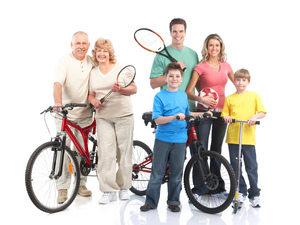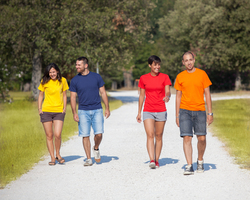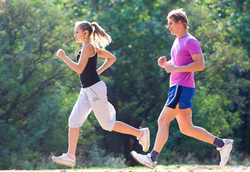

In today’s American society, we have numerous luxuries and conveniences which require limited physical activity in our daily lives. What activity we do is based upon personal choice and our environmental conditions. So, we must live somewhere that is activity-friendly and want to be active. Our low levels of activity are contributing to the burdens of chronic health problems and overweight/obesity issues. No one says we can’t enjoy relaxing and watching TV, using social media, or playing video games. But, much like unhealthy eating habits, we need to do so in moderation and plan for how we can be physically active each day. If we don’t move more and consume fewer calories with more nutritious foods, we will continue living a life out of balance!
The U.S. Department of Health and Human Services developed Physical Activity Guidelines for Americans which are recommendations based upon scientific research. The guidelines identify different levels of physical activity -- Baseline activity and Health-enhancing activity. Both are necessary components to a healthy lifestyle.

Baseline activity is the light intensity activities do each day (e.g. sitting, standing, walking, carrying lightweight objects), as well as the short-duration moderate and vigorous intensity activities we may include (e.g. climbing stairs).

Health-enhancing activity is more vigorous, longer in duration, and may be planned into one’s day (e.g. brisk walking, dancing, lifting weights, jogging, yoga, climbing around the playground).
Increasing baseline activity as a rule will help burn more calories (which is waistline friendly), may improve bone health (if weight-bearing in nature), may be more environmentally friendly, and could increase social acceptance of being a physically active society. So, the benefits go beyond a single person’s health or appearance. Planning health-enhancing physical activity also goes beyond physical health, to also improve emotional health. It can offer extra social opportunities, allow you to have fun, and improve your fitness to be successful with other physically active tasks. Physical activity in childhood is essential for proper growth and development. But the need to be active does not stop there, and should be a focus for a lifetime. It is never too late to start becoming active. Every little bit of baseline and health-enhancing physical activity we incorporate in our lives will allow us to progress to a greater level of wellness.
The current Physical Activity Guidelines recommend a minimum of 150 minutes per week of moderate intensity activity. We can accomplish this by planning some form of health-enhancing physical activity into our daily lives. Recognize that might mean multiple 10-minute intervals each day if we cannot carve out a full 30 minutes together. We lead busy lives with competing demands on our time, so it is extremely important to find a compromise with what you expect from yourself as far as physical activity. Decide what types of activity you wish to include and whether you would benefit from forming a network of supports to get active with you.
There is no “right way” to be active so come up with a personal plan that fits you and your lifestyle. Start small and build your way up to your end goal. Much like a baby learns to walk—we must crawl and take tiny steps with support before we can walk. Create a plan that allows you to enjoy smaller successes in order to build up to your greater plan. Make sure you define your goals in ways that you will be able to measure your success. A general goal might be “I will exercise more often.” To increase the likelihood of success, make that goal more specific. For example, “I will take (one) 10-minute walk daily for a week, then increase to (two) 10-minute walks daily for a second week. The third week, I will take (three) 10-minute walks through the day/night, and will maintain this plan for at least a month.” New habits take a few weeks to develop so begin small and figure out what barriers you may need to overcome before committing to your full goal. It is often when we hit the first road blocks and struggle to find a solution to get past them that we give up.
For more information on the Physical Activity Guidelines for Americans, ideas for how to succeed in incorporating more daily activity at any age, and exercise videos, check out the links for related resources on the Healthy Habits page.






